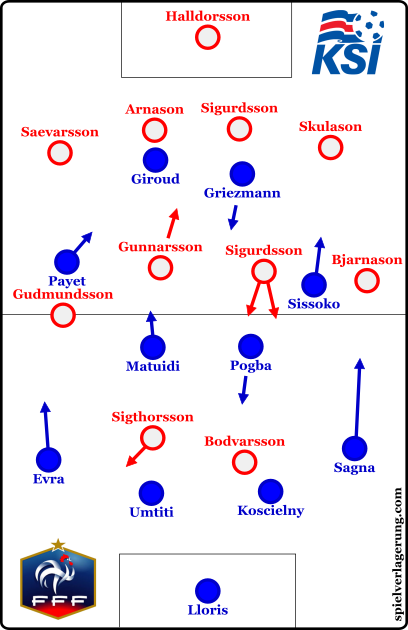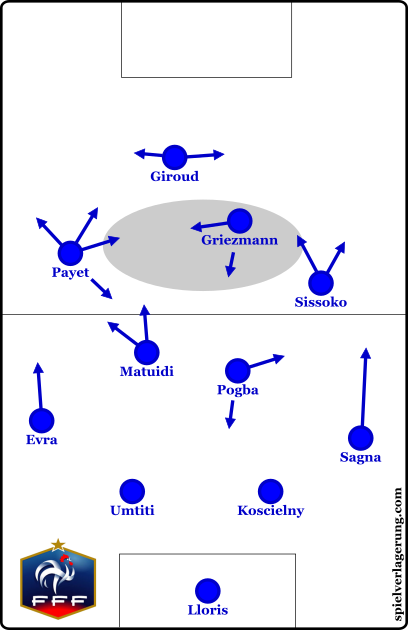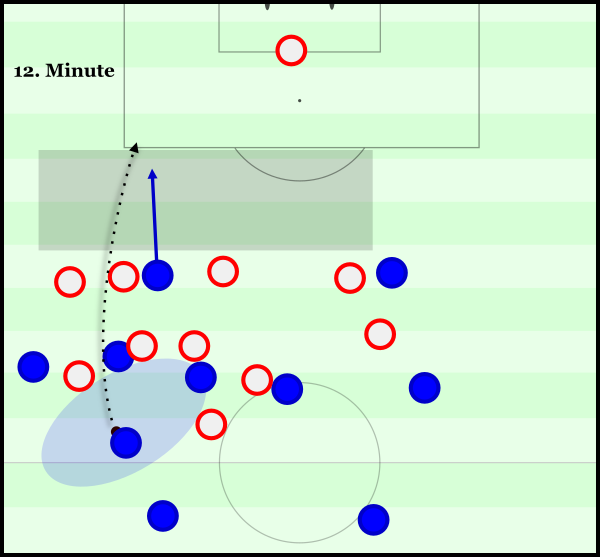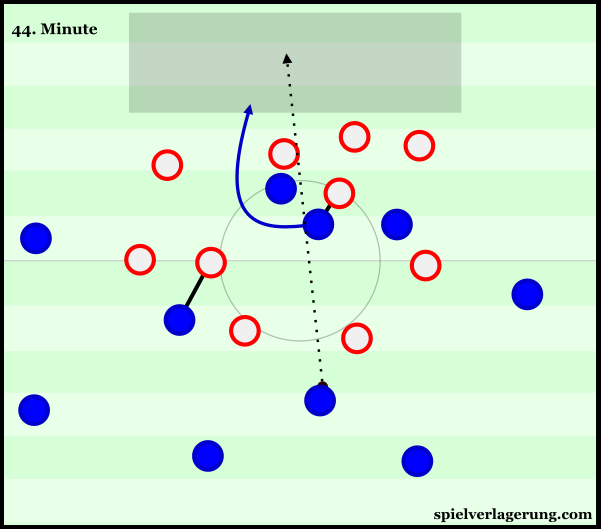France end Icelandic dreams with central focus and through-balls
In stark contrast to the previous night’s tight affair, France made their way to the semi-finals with ease as they breezed past a disappointing Iceland side. Deschamps opted for an interesting asymmetrical 4-4-2 formation with Pogba at the 6 whilst Iceland went for the same 4-4-2 which knocked England out in the last round.
French Offensive Fluidity
Despite lining up in a 4-4-2, France only resembled such a shape without possession as they attacked with impressive flexibility and dynamic. Payet drifted inside whilst Griezmann preferred to drop into the 10 space with the attack enjoying a level of freedom in their positioning off of the ball.
As a result, Deschamps’ side rarely had a fixed shape to denote them by. With Sissoko moving up through on the right of midfield, they showed as a 4-2-3-1 at times but not for long periods of time. They showed somewhat asymmetrical during many scenes due to the orientation of the two ‘wide’ players. Sissoko offered a direct presence in his runs through the right half-space and was alternatively acting wide whilst Payet dropped inside towards the centre and open pockets within the left half-space
This outing showed the best of France’s spacing this tournament. Despite the fluidity of the shape, the positioning of the forwards was coordinated well and they distributed themselves effectively across the attack. Their forwards were frequently able to find gaps against an Icelandic defence which had previously nullified others. Being one of the most important tactical aspects of football, France’s effective spacing was a key part in everything they did. By distributing themselves with efficiency across the pitch, they were able to stop Iceland from covering the central overloads formed and they gave players like Dimitri Payet the necessary room to be a threat in the centre.
In what was a rather attacking shape, balance was provided by the more-deeply positioned Matuidi and Pogba. The latter was surprisingly the deepest midfielder in the shape and would drop into the defensive line on some occasions. The pairing was rarely under pressure from the Icelandic defence and thus could control the game fairly easily with the more attacking-minded four ahead of them.
This fluidity in attack gave France a useful level of variation in possession of the ball. Both Griezmann and Payet actively changed their movements off of the ball and thus could threaten in multiple zones on the pitch. The central-focus of the French allowed their technical players to cooperate in combinations from within Iceland’s defence. In doing so, they could maintain possession in more advanced positions or open space for teammates, such as with Payet’s 5th minute strike.

France were able to maintain control over the ball within Iceland’s defence due to the strong spacing.
With the luxury of taking the lead early (and not throwing it away minutes later), France could take a more conservative approach to the game and build-up with a slow tempo. After taking a 2-0 lead, France were happy to develop possession in a less aggressive manner and were happy at times to pass the ball back towards the defence if it meant maintaining possession.
Overloading the Icelandic midfield
France’s structure in possession was based largely around one intention – overloading the Icelandic midfield. Whilst Bjarnason and Gudmundsson were both more attentive to the movements of the French full-backs, the two central midfielders were left overloaded by the shifting forwards. With Payet, Griezmann and often Sissoko convening through the centre, a 3v2 (and at times, a 4v2) was formed down the middle against Gunnarsson and Sigurdsson.
This allowed France to create free men through the middle of the pitch with Iceland understandably struggling to cover all three players. Their dynamic movements served to exaggerate the overload as they disoriented Iceland’s zonal defence. By frequently changing their path in midfield, players such as Payet could appear in different pockets of space in each scene.
It was unsurprising to see France focus their efforts around their two best forwards – Payet and Griezmann. Many attempts to break through the opponent’s midfield were based around the left half-space and the left of the centre where both could be frequently found.
Although the two Icelandic strikers would offer their presence in supporting the midfield, it was only partly effective. A 4-4-2-0 shape was created at times by the Iceland defence with the intentions of securing a midfield occupied by effectively 6 players. Yet with no occupation of the higher zones, France reacted by allowing Pogba and/or Matuidi to move higher where they could re-create such overloads. This created a significant pressure on the Icelandic defensive block already took a conservative approach on the game and it showed. France were able to regain the ball frequently within the midfield to enforce a fairly constant attack.
Exploiting the high defensive line
Whilst this wasn’t a major issue in their 2-1 win over England, as Hodgson’s side had little strategy in way of exploiting it after the first 5 minutes, France were much less forgiving. Pairing a highly-positioned defensive line with a lack of pressure in the midfield is rarely an effective combination in football as the hosts went on to show.
Without pressure in midfield, the opposition are generally unchallenged and have the time and space to make accurate passes. This is the perfect cue for strikers, particularly with the pace of Griezmann, to make runs behind the defence in search of a through-ball. With the high defensive line, a bigger gap is free in front of the goalkeeper which not only gives greater margin of error for the through-ball, but allows the forward more time in the one-on-one.
It took France just 12 minutes in for them to capitalise on this defensive flaw. With the attacking midfield trio occupying the Icelandic midfield, Matuidi was under no pressure at the half-way line. The PSG midfield could easily pick out the run of Olivier Giroud who had peeled off of his man and ran into the space behind the defensive line. Without any oppositional pressure, Matuidi’s pass was near-perfect onto the run of Giroud and the Arsenal forward made an emphatic finish to put the hosts up.
Iceland show variability
Where Iceland’s direct game had seen them threaten a number of defences so far in the EUROs, it was interesting to see them take alternative approaches to breaking through the French back-line. Although the long-ball option of Sigthorsson was still there, Lagerbäck’s side were more inclined to moving the ball through the midfield. Whilst this displayed a side we haven’t perhaps seen from the team yet, their attempts were often in vain with the front two disconnected from the possession.
Whilst the media has paid large attention to Iceland’s long ball and throw-in game, they aren’t as one-dimensional as one might believe. Although they weren’t the most dynamic team of the tournament, they offered threats in other areas as they looked to play through the midfield at times. Vertical passes were attempted occasionally as they looked to integrate the wingers and forwards through ground-passing too. Alternatively, French turnovers in the same area resulted in a couple of potentially-dangerous counter-attacking situations.
During Iceland’s build-up, Deschamps’ side took a fairly passive approach to the game and rarely looked to actually press their opposition. Considering Iceland’s direct approach in the build-up, this may have been in an effort to keep greater numbers in deeper positions. Alternatively, the side may have had their focus set on Germany just four days away.
Either way, Iceland benefited somewhat from the lack of pressure on their centre-backs. They not only had a greater capacity to make accurate passes into the front line in the absence of defensive pressure, but could take up higher positions too. With Giroud and Griezmann only pressing in deeper areas, the Icelandic defence could move higher before playing the long ball, allowing it to reach Sigthorsson and Bodvarsson further upfield.
2nd Half Developments
With the game effectively over, Lagerbäck made two personnel changes at half-time with Ingason replacing Arnason in defence whilst Finnbogason was introduced in the attack as Bodvarsson’s tournament finished. Despite changes, the side maintained their 4-4-2 shape. In contrast, Deschamps’ side unsurprisingly resumed play with the same shape as they had ended their very successful first 45.
Although it was far from all-out-attack, Iceland took a more offensive stance on the game. In defence, the two strikers offered less support in deep areas and instead were more inclined to stay close to the half-way line. The minnows showed more threat within France’s final third and were able to create a number of chances throughout the second half. However with the score at 4-0, the game was already over and France had shifted their focus to next Thursday.
France resumed in their conservative approach and maintained the steady ball circulation in possession. Happy to see the game out with less energy exerted, Deschamps’ side were more content to cede possession to the Iceland side who were not as direct as in previous outings. With Iceland seeing more of the possession, they were able to further demonstrate the variety in their play and produced some strong chances in doing so. Unfortunately for the Nordic side, these chances came far too late in the game with the result already decided.
Conclusion
Whilst their semi-final opponents Germany scraped through on penalties, France had a much simpler passage into the last four. Iceland’s defensive performance was on a similar level as in their 2-1 win over England, yet Deschamps’ side broke through with much greater ease. The gameplan to overload the centre was an effective one, whilst their high defensive line was exposed when the midfield pressure wasn’t sufficient.







Keine Kommentare vorhanden Alle anzeigen